1998 OPEL FRONTERA air condition
[x] Cancel search: air conditionPage 3520 of 6000
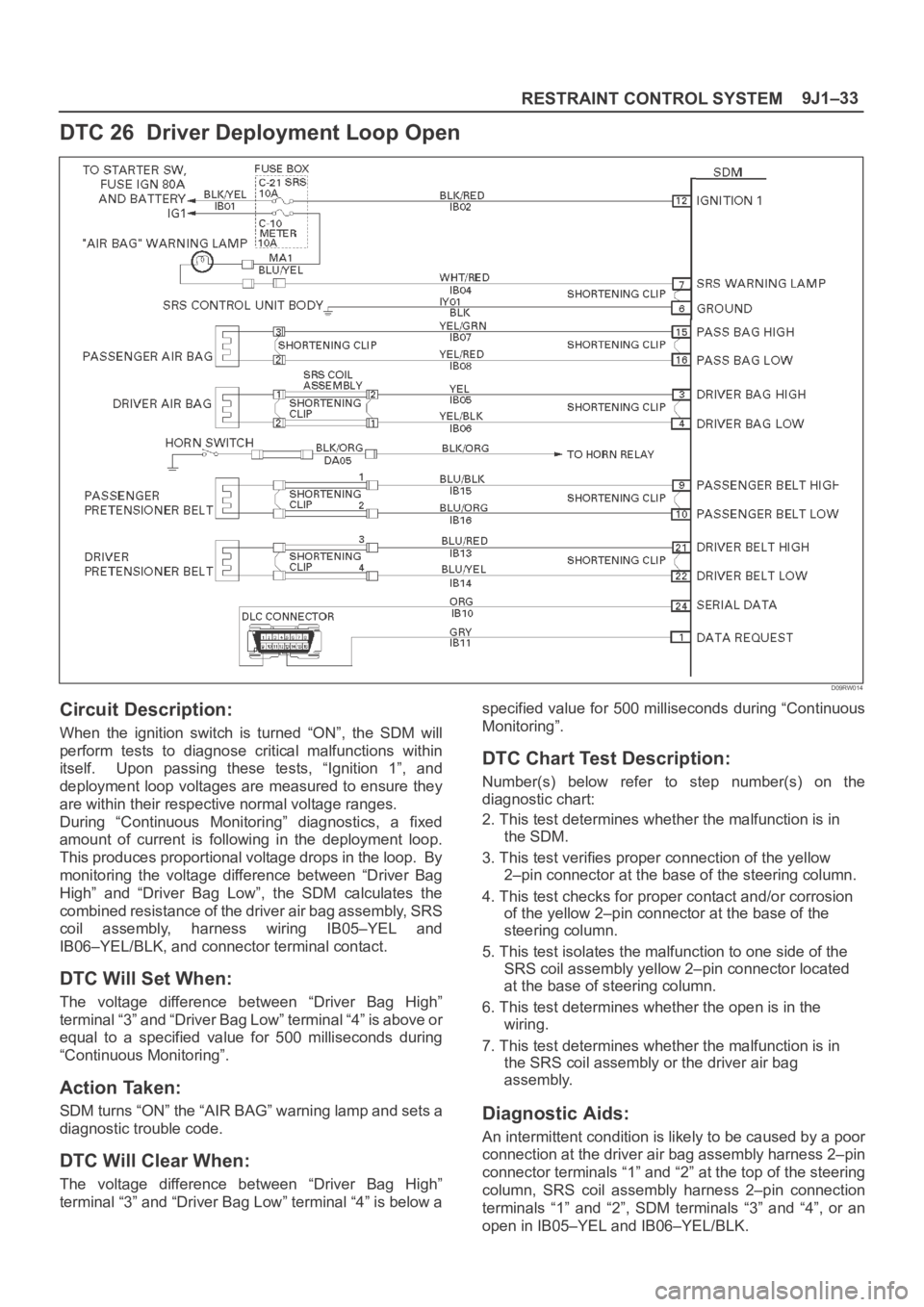
9J1–33
RESTRAINT CONTROL SYSTEM
DTC 26 Driver Deployment Loop Open
D09RW014
Circuit Description:
When the ignition switch is turned “ON”, the SDM will
perform tests to diagnose critical malfunctions within
itself. Upon passing these tests, “Ignition 1”, and
deployment loop voltages are measured to ensure they
are within their respective normal voltage ranges.
During “Continuous Monitoring” diagnostics, a fixed
amount of current is following in the deployment loop.
This produces proportional voltage drops in the loop. By
monitoring the voltage difference between “Driver Bag
High” and “Driver Bag Low”, the SDM calculates the
combined resistance of the driver air bag assembly, SRS
coil assembly, harness wiring IB05–YEL and
IB06–YEL/BLK, and connector terminal contact.
DTC Will Set When:
The voltage difference between “Driver Bag High”
terminal “3” and “Driver Bag Low” terminal “4” is above or
equal to a specified value for 500 milliseconds during
“Continuous Monitoring”.
Action Taken:
SDM turns “ON” the “AIR BAG” warning lamp and sets a
diagnostic trouble code.
DTC Will Clear When:
The voltage difference between “Driver Bag High”
terminal “3” and “Driver Bag Low” terminal “4” is below aspecified value for 500 milliseconds during “Continuous
Monitoring”.
DTC Chart Test Description:
Number(s) below refer to step number(s) on the
diagnostic chart:
2. This test determines whether the malfunction is in
the SDM.
3. This test verifies proper connection of the yellow
2–pin connector at the base of the steering column.
4. This test checks for proper contact and/or corrosion
of the yellow 2–pin connector at the base of the
steering column.
5. This test isolates the malfunction to one side of the
SRS coil assembly yellow 2–pin connector located
at the base of steering column.
6. This test determines whether the open is in the
wiring.
7. This test determines whether the malfunction is in
the SRS coil assembly or the driver air bag
assembly.
Diagnostic Aids:
An intermittent condition is likely to be caused by a poor
connection at the driver air bag assembly harness 2–pin
connector terminals “1” and “2” at the top of the steering
column, SRS coil assembly harness 2–pin connection
terminals “1” and “2”, SDM terminals “3” and “4”, or an
open in IB05–YEL and IB06–YEL/BLK.
Page 3528 of 6000
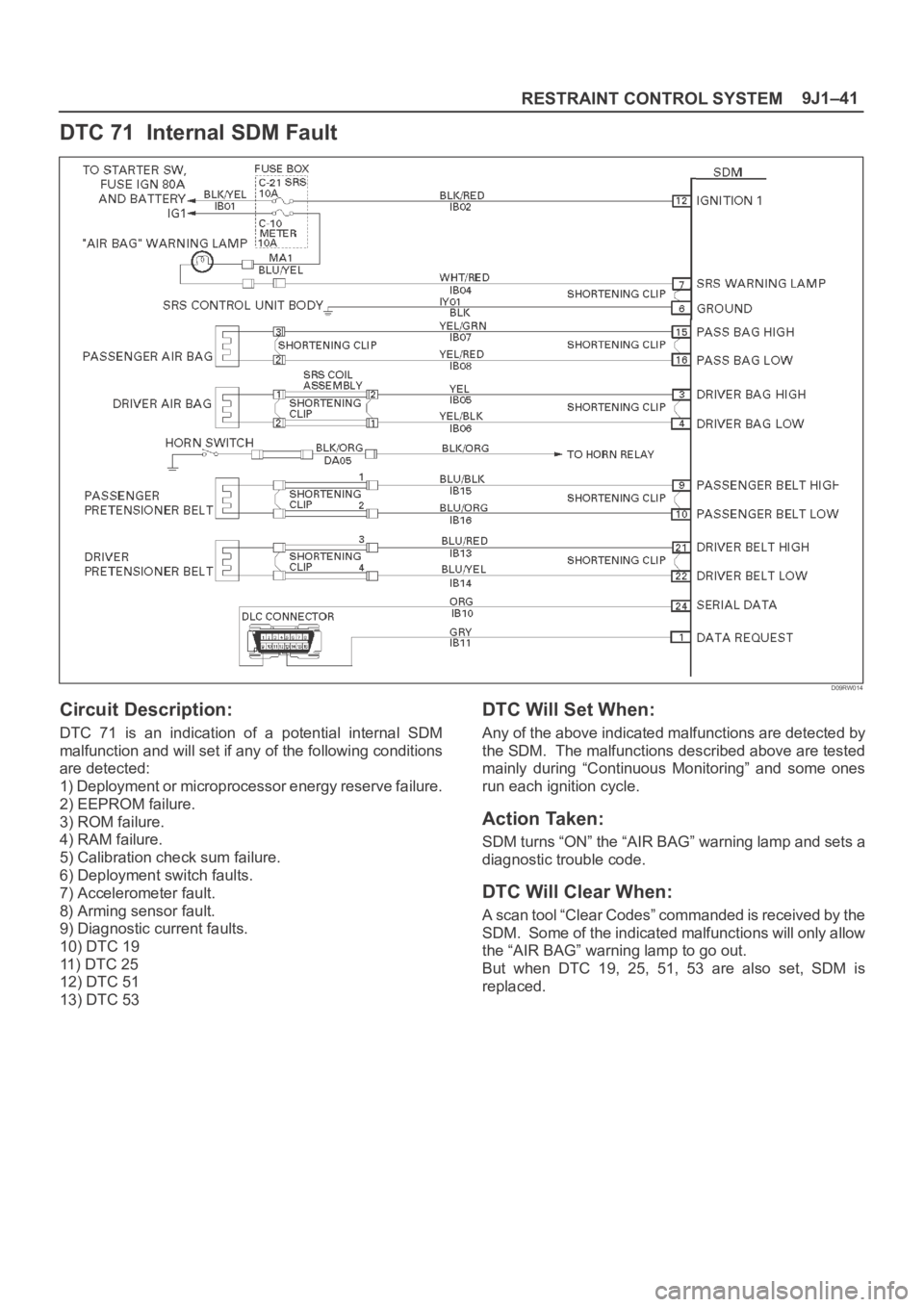
9J1–41
RESTRAINT CONTROL SYSTEM
DTC 71 Internal SDM Fault
D09RW014
Circuit Description:
DTC 71 is an indication of a potential internal SDM
malfunction and will set if any of the following conditions
are detected:
1) Deployment or microprocessor energy reserve failure.
2) EEPROM failure.
3) ROM failure.
4) RAM failure.
5) Calibration check sum failure.
6) Deployment switch faults.
7) Accelerometer fault.
8) Arming sensor fault.
9) Diagnostic current faults.
10) DTC 19
11 ) D T C 2 5
12) DTC 51
13) DTC 53
DTC Will Set When:
Any of the above indicated malfunctions are detected by
the SDM. The malfunctions described above are tested
mainly during “Continuous Monitoring” and some ones
run each ignition cycle.
Action Taken:
SDM turns “ON” the “AIR BAG” warning lamp and sets a
diagnostic trouble code.
DTC Will Clear When:
A scan tool “Clear Codes” commanded is received by the
SDM. Some of the indicated malfunctions will only allow
the “AIR BAG” warning lamp to go out.
But when DTC 19, 25, 51, 53 are also set, SDM is
replaced.
Page 3529 of 6000

RESTRAINT CONTROL SYSTEM 9J1–42
DTC 71 Internal SDM Fault
WARNING: DURING SERVICE PROCEDURES. BE VERY CAREFUL WHEN HANDLING A SENSING AND
DIAGNOSTIC MODULE (SDM). NEVER STRIKE OR JAR THE SDM. NEVER POWER UP THE SRS WHEN THE
SDM IS NOT RIGIDLY ATTACHED TO THE VEHICLE. ALL SDM AND MOUNTING BRACKET FASTENERS MUST
BE CAREFULLY TORQUED AND THE ARROW MUST BE POINTING TOWARD THE FRONT OF THE VEHICLE
TO ENSURE PROPER OPERATION OF THE SRS. THE SDM COULD BE ACTIVATED WHEN POWERED WHILE
NOT RIGIDLY ATTACHED TO THE VEHICLE WHICH COULD CAUSE DEPLOYMENT AND RESULT IN
PERSONAL INJURY.
CAUTION: When DTC 19 or 25 has been set, it is necessary to replace the SDM. Setting DTC 19 and 25 or 51
or 53 will also cause DTC 71 to set. When a scan tool “CLEAR CODES” command is issued and the
malfunction is no longer present, DTC 51 or 53 and DTC 71 will remain current. Ensure that the short to voltage
condition DTC 19, 25 is repaired prior to installing a replacement SDM to avoid damaging the SDM.
Step
ActionYe sNo
1Was the “SRS Diagnostic System Check” performed?
Go to Step 2
Go to the “SRS
Diagnostic
System Check”
2Note SRS “Diagnostic System Check.”
IS DTC 19 OR 25 OR 51 OR 53 ALSO SET (CURRENT OR
HISTORY)? (REFER TO NOTICE ABOVE.)Go to DTC 19 if
DTC 19 is set
Go to DTC 25 if
DTC 25 is set
Go to DTC 51 if
DTC 51 is set
Go to DTC 53 if
DTC 53 is set
Ignition switch
“OFF”
Replace SDM
Repeat the “SRS
Diagnostic
System Check”
Page 3530 of 6000
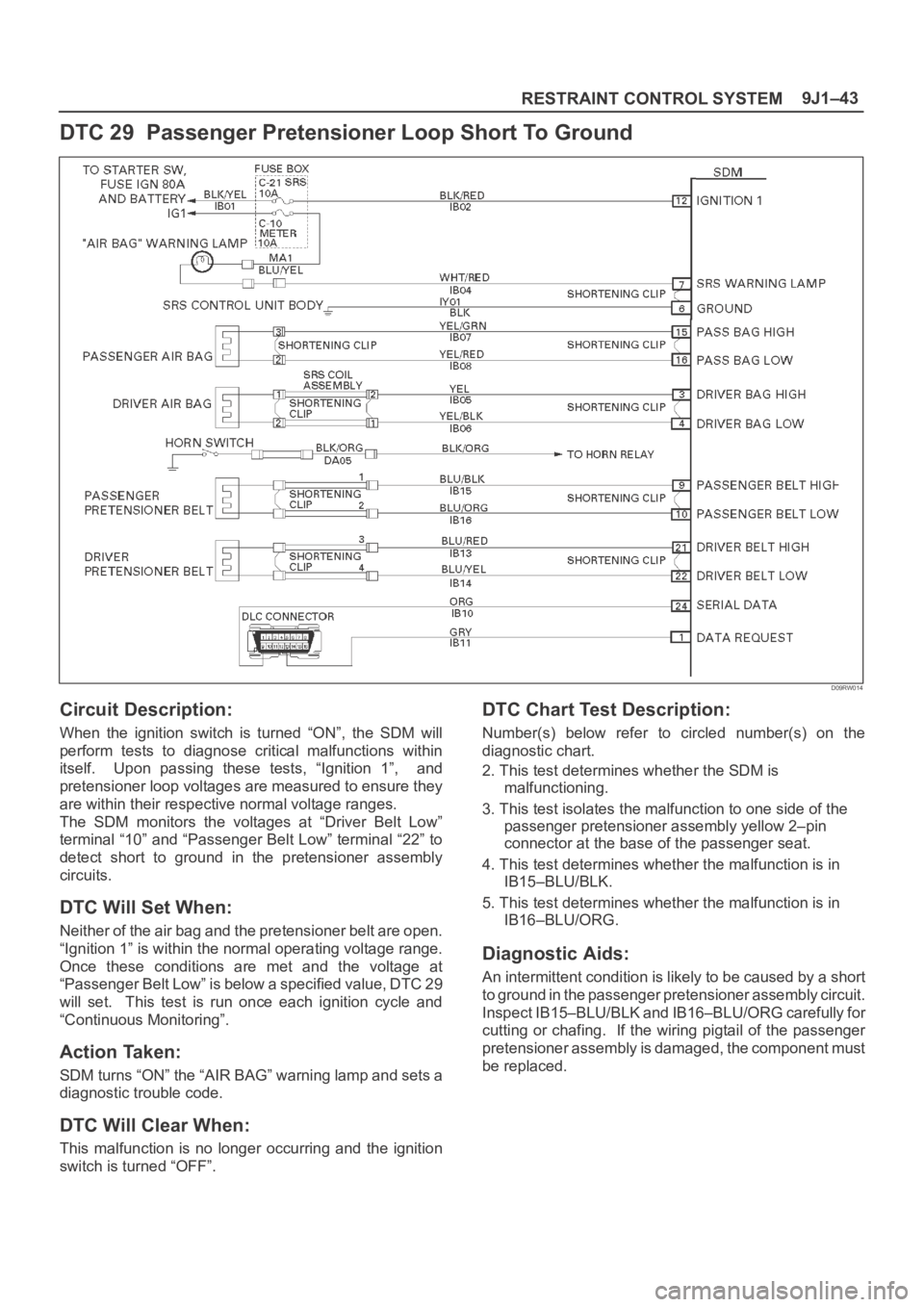
9J1–43
RESTRAINT CONTROL SYSTEM
DTC 29 Passenger Pretensioner Loop Short To Ground
D09RW014
Circuit Description:
When the ignition switch is turned “ON”, the SDM will
perform tests to diagnose critical malfunctions within
itself. Upon passing these tests, “Ignition 1”, and
pretensioner loop voltages are measured to ensure they
are within their respective normal voltage ranges.
The SDM monitors the voltages at “Driver Belt Low”
terminal “10” and “Passenger Belt Low” terminal “22” to
detect short to ground in the pretensioner assembly
circuits.
DTC Will Set When:
Neither of the air bag and the pretensioner belt are open.
“Ignition 1” is within the normal operating voltage range.
Once these conditions are met and the voltage at
“Passenger Belt Low” is below a specified value, DTC 29
will set. This test is run once each ignition cycle and
“Continuous Monitoring”.
Action Taken:
SDM turns “ON” the “AIR BAG” warning lamp and sets a
diagnostic trouble code.
DTC Will Clear When:
This malfunction is no longer occurring and the ignition
switch is turned “OFF”.
DTC Chart Test Description:
Number(s) below refer to circled number(s) on the
diagnostic chart.
2. This test determines whether the SDM is
malfunctioning.
3. This test isolates the malfunction to one side of the
passenger pretensioner assembly yellow 2–pin
connector at the base of the passenger seat.
4. This test determines whether the malfunction is in
IB15–BLU/BLK.
5. This test determines whether the malfunction is in
IB16–BLU/ORG.
Diagnostic Aids:
An intermittent condition is likely to be caused by a short
to ground in the passenger pretensioner assembly circuit.
Inspect IB15–BLU/BLK and IB16–BLU/ORG carefully for
cutting or chafing. If the wiring pigtail of the passenger
pretensioner assembly is damaged, the component must
be replaced.
Page 3532 of 6000
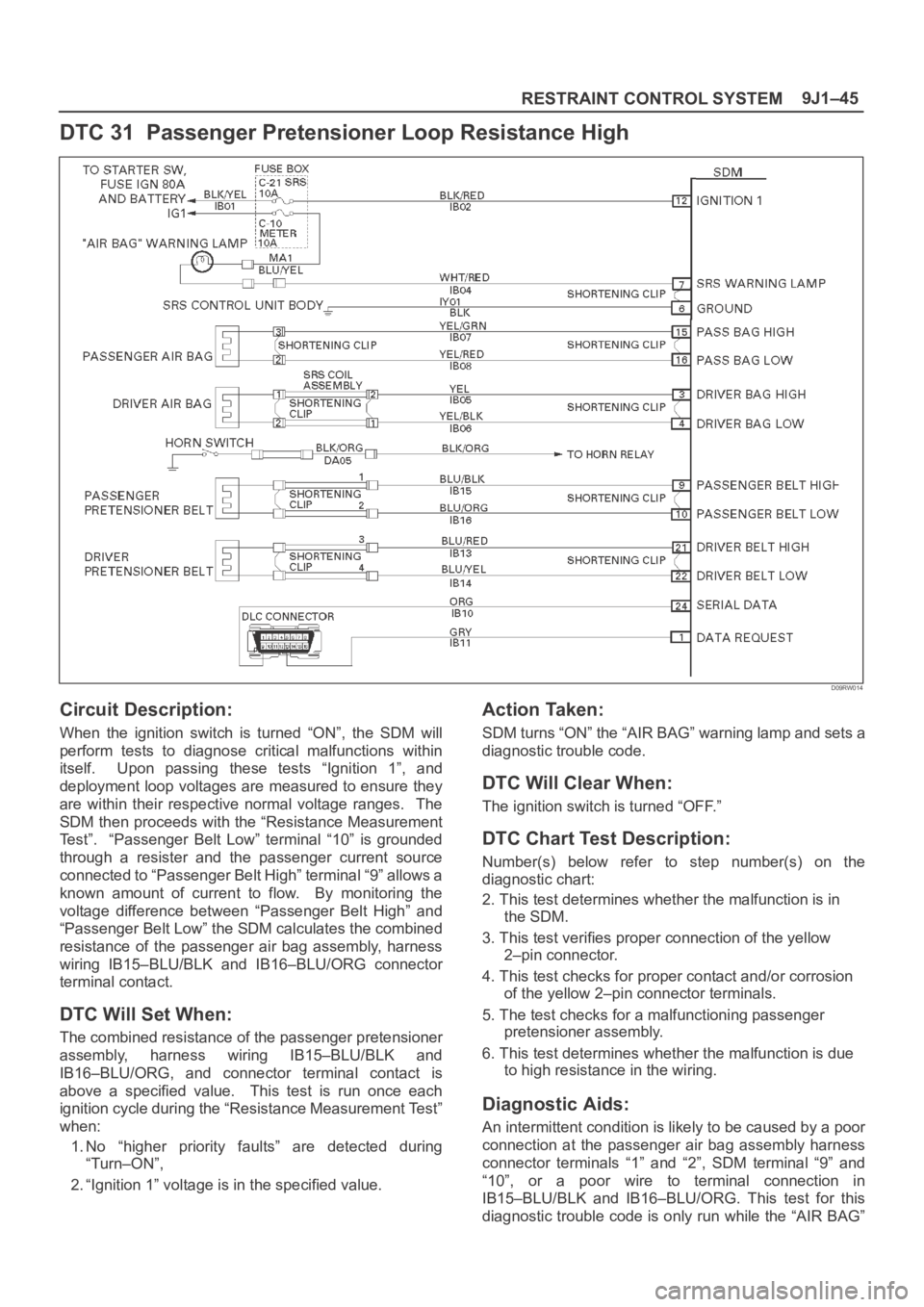
9J1–45
RESTRAINT CONTROL SYSTEM
DTC 31 Passenger Pretensioner Loop Resistance High
D09RW014
Circuit Description:
When the ignition switch is turned “ON”, the SDM will
perform tests to diagnose critical malfunctions within
itself. Upon passing these tests “Ignition 1”, and
deployment loop voltages are measured to ensure they
are within their respective normal voltage ranges. The
SDM then proceeds with the “Resistance Measurement
Test”. “Passenger Belt Low” terminal “10” is grounded
through a resister and the passenger current source
connected to “Passenger Belt High” terminal “9” allows a
known amount of current to flow. By monitoring the
voltage difference between “Passenger Belt High” and
“Passenger Belt Low” the SDM calculates the combined
resistance of the passenger air bag assembly, harness
wiring IB15–BLU/BLK and IB16–BLU/ORG connector
terminal contact.
DTC Will Set When:
The combined resistance of the passenger pretensioner
assembly, harness wiring IB15–BLU/BLK and
IB16–BLU/ORG, and connector terminal contact is
above a specified value. This test is run once each
ignition cycle during the “Resistance Measurement Test”
when:
1. No “higher priority faults” are detected during
“Turn–ON”,
2. “Ignition 1” voltage is in the specified value.
Action Taken:
SDM turns “ON” the “AIR BAG” warning lamp and sets a
diagnostic trouble code.
DTC Will Clear When:
The ignition switch is turned “OFF.”
DTC Chart Test Description:
Number(s) below refer to step number(s) on the
diagnostic chart:
2. This test determines whether the malfunction is in
the SDM.
3. This test verifies proper connection of the yellow
2–pin connector.
4. This test checks for proper contact and/or corrosion
of the yellow 2–pin connector terminals.
5. The test checks for a malfunctioning passenger
pretensioner assembly.
6. This test determines whether the malfunction is due
to high resistance in the wiring.
Diagnostic Aids:
An intermittent condition is likely to be caused by a poor
connection at the passenger air bag assembly harness
connector terminals “1” and “2”, SDM terminal “9” and
“10”, or a poor wire to terminal connection in
IB15–BLU/BLK and IB16–BLU/ORG. This test for this
diagnostic trouble code is only run while the “AIR BAG”
Page 3534 of 6000
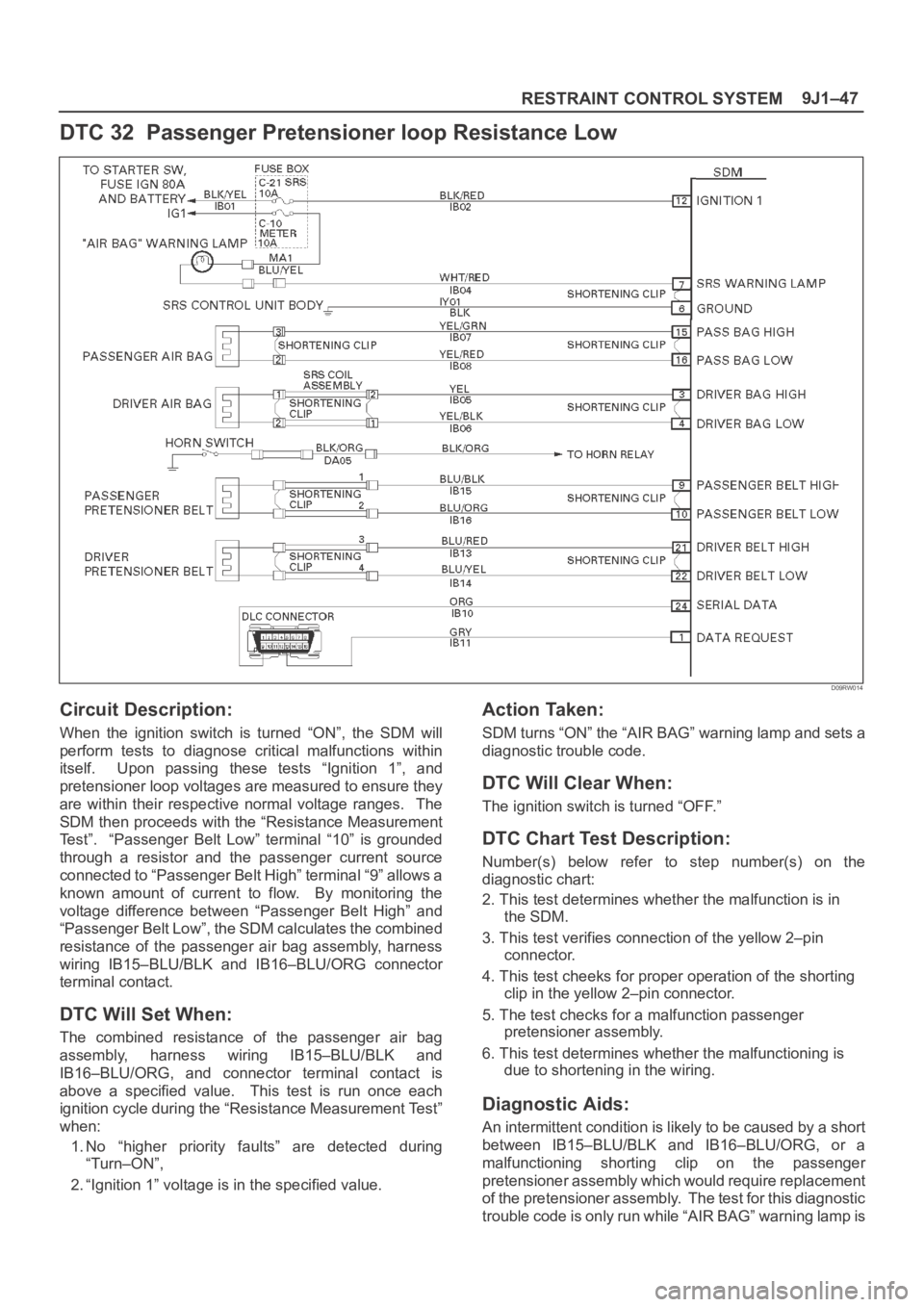
9J1–47
RESTRAINT CONTROL SYSTEM
DTC 32 Passenger Pretensioner loop Resistance Low
D09RW014
Circuit Description:
When the ignition switch is turned “ON”, the SDM will
perform tests to diagnose critical malfunctions within
itself. Upon passing these tests “Ignition 1”, and
pretensioner loop voltages are measured to ensure they
are within their respective normal voltage ranges. The
SDM then proceeds with the “Resistance Measurement
Test”. “Passenger Belt Low” terminal “10” is grounded
through a resistor and the passenger current source
connected to “Passenger Belt High” terminal “9” allows a
known amount of current to flow. By monitoring the
voltage difference between “Passenger Belt High” and
“Passenger Belt Low”, the SDM calculates the combined
resistance of the passenger air bag assembly, harness
wiring IB15–BLU/BLK and IB16–BLU/ORG connector
terminal contact.
DTC Will Set When:
The combined resistance of the passenger air bag
assembly, harness wiring IB15–BLU/BLK and
IB16–BLU/ORG, and connector terminal contact is
above a specified value. This test is run once each
ignition cycle during the “Resistance Measurement Test”
when:
1. No “higher priority faults” are detected during
“Turn–ON”,
2. “Ignition 1” voltage is in the specified value.
Action Taken:
SDM turns “ON” the “AIR BAG” warning lamp and sets a
diagnostic trouble code.
DTC Will Clear When:
The ignition switch is turned “OFF.”
DTC Chart Test Description:
Number(s) below refer to step number(s) on the
diagnostic chart:
2. This test determines whether the malfunction is in
the SDM.
3. This test verifies connection of the yellow 2–pin
connector.
4. This test cheeks for proper operation of the shorting
clip in the yellow 2–pin connector.
5. The test checks for a malfunction passenger
pretensioner assembly.
6. This test determines whether the malfunctioning is
due to shortening in the wiring.
Diagnostic Aids:
An intermittent condition is likely to be caused by a short
between IB15–BLU/BLK and IB16–BLU/ORG, or a
malfunctioning shorting clip on the passenger
pretensioner assembly which would require replacement
of the pretensioner assembly. The test for this diagnostic
trouble code is only run while “AIR BAG” warning lamp is
Page 3536 of 6000
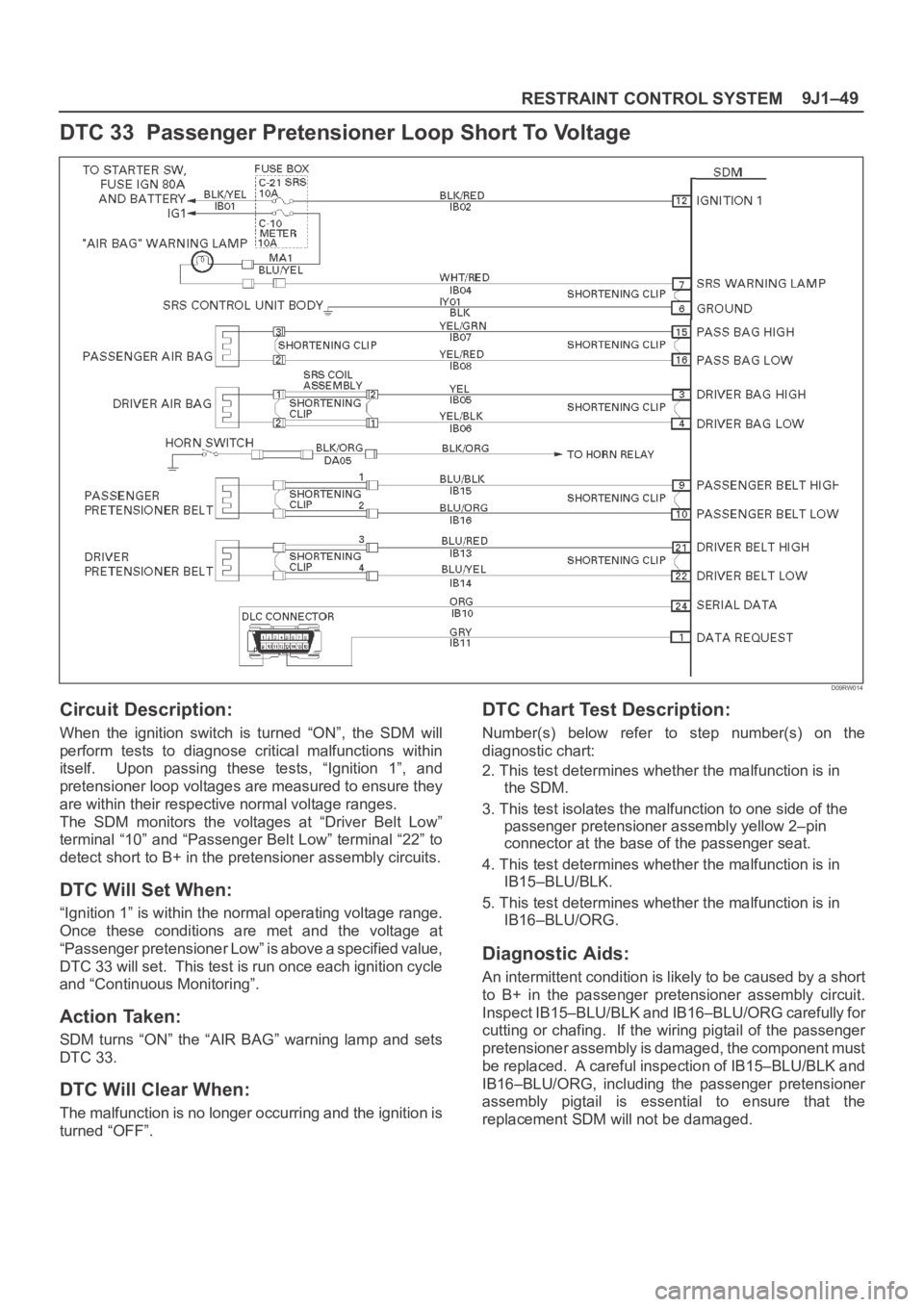
9J1–49
RESTRAINT CONTROL SYSTEM
DTC 33 Passenger Pretensioner Loop Short To Voltage
D09RW014
Circuit Description:
When the ignition switch is turned “ON”, the SDM will
perform tests to diagnose critical malfunctions within
itself. Upon passing these tests, “Ignition 1”, and
pretensioner loop voltages are measured to ensure they
are within their respective normal voltage ranges.
The SDM monitors the voltages at “Driver Belt Low”
terminal “10” and “Passenger Belt Low” terminal “22” to
detect short to B+ in the pretensioner assembly circuits.
DTC Will Set When:
“Ignition 1” is within the normal operating voltage range.
Once these conditions are met and the voltage at
“Passenger pretensioner Low” is above a specified value,
DTC 33 will set. This test is run once each ignition cycle
and “Continuous Monitoring”.
Action Taken:
SDM turns “ON” the “AIR BAG” warning lamp and sets
DTC 33.
DTC Will Clear When:
The malfunction is no longer occurring and the ignition is
turned “OFF”.
DTC Chart Test Description:
Number(s) below refer to step number(s) on the
diagnostic chart:
2. This test determines whether the malfunction is in
the SDM.
3. This test isolates the malfunction to one side of the
passenger pretensioner assembly yellow 2–pin
connector at the base of the passenger seat.
4. This test determines whether the malfunction is in
IB15–BLU/BLK.
5. This test determines whether the malfunction is in
IB16–BLU/ORG.
Diagnostic Aids:
An intermittent condition is likely to be caused by a short
to B+ in the passenger pretensioner assembly circuit.
Inspect IB15–BLU/BLK and IB16–BLU/ORG carefully for
cutting or chafing. If the wiring pigtail of the passenger
pretensioner assembly is damaged, the component must
be replaced. A careful inspection of IB15–BLU/BLK and
IB16–BLU/ORG, including the passenger pretensioner
assembly pigtail is essential to ensure that the
replacement SDM will not be damaged.
Page 3538 of 6000
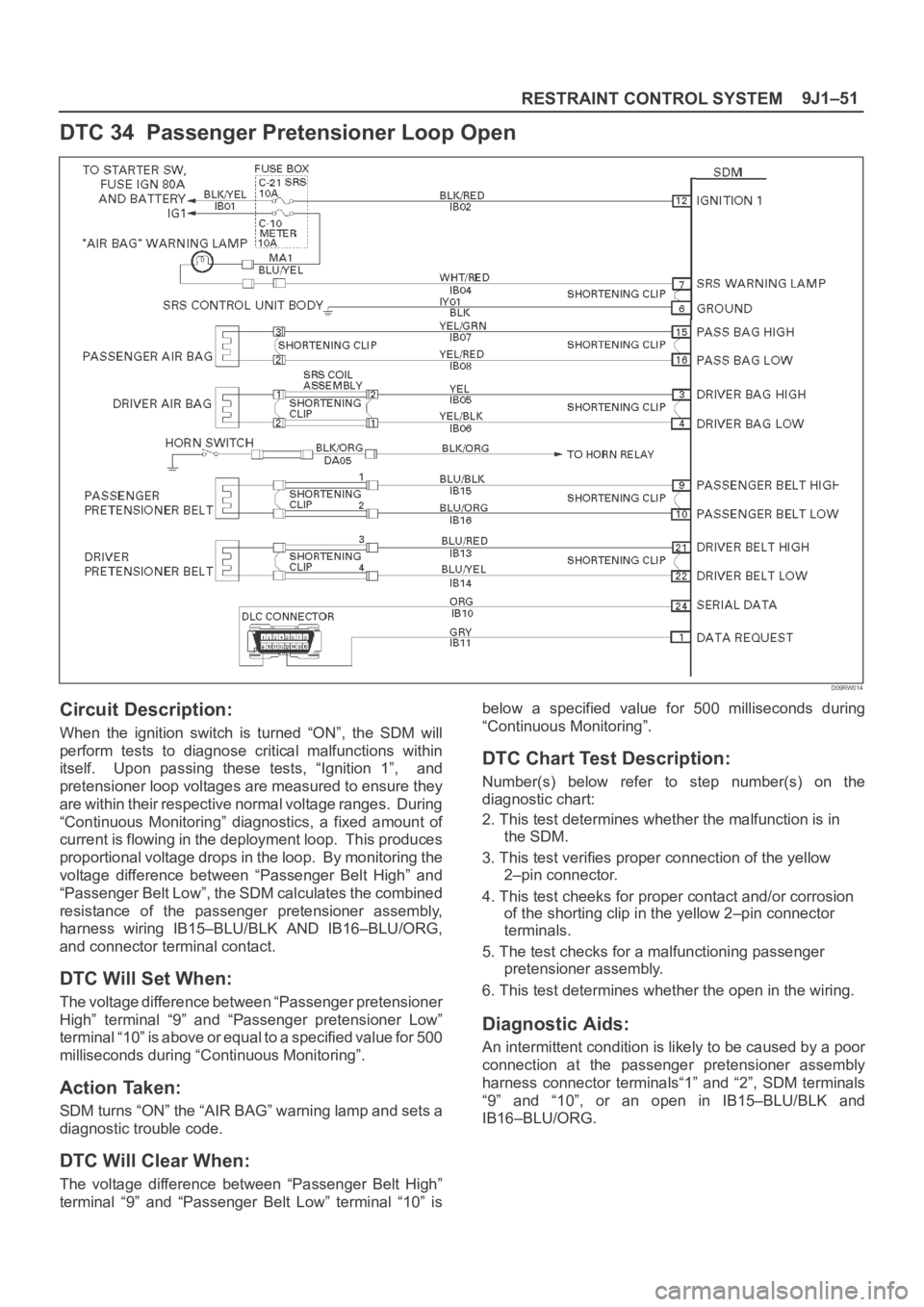
9J1–51
RESTRAINT CONTROL SYSTEM
DTC 34 Passenger Pretensioner Loop Open
D09RW014
Circuit Description:
When the ignition switch is turned “ON”, the SDM will
perform tests to diagnose critical malfunctions within
itself. Upon passing these tests, “Ignition 1”, and
pretensioner loop voltages are measured to ensure they
are within their respective normal voltage ranges. During
“Continuous Monitoring” diagnostics, a fixed amount of
current is flowing in the deployment loop. This produces
proportional voltage drops in the loop. By monitoring the
voltage difference between “Passenger Belt High” and
“Passenger Belt Low”, the SDM calculates the combined
resistance of the passenger pretensioner assembly,
harness wiring IB15–BLU/BLK AND IB16–BLU/ORG,
and connector terminal contact.
DTC Will Set When:
The voltage difference between “Passenger pretensioner
High” terminal “9” and “Passenger pretensioner Low”
terminal “10” is above or equal to a specified value for 500
milliseconds during “Continuous Monitoring”.
Action Taken:
SDM turns “ON” the “AIR BAG” warning lamp and sets a
diagnostic trouble code.
DTC Will Clear When:
The voltage difference between “Passenger Belt High”
terminal “9” and “Passenger Belt Low” terminal “10” isbelow a specified value for 500 milliseconds during
“Continuous Monitoring”.
DTC Chart Test Description:
Number(s) below refer to step number(s) on the
diagnostic chart:
2. This test determines whether the malfunction is in
the SDM.
3. This test verifies proper connection of the yellow
2–pin connector.
4. This test cheeks for proper contact and/or corrosion
of the shorting clip in the yellow 2–pin connector
terminals.
5. The test checks for a malfunctioning passenger
pretensioner assembly.
6. This test determines whether the open in the wiring.
Diagnostic Aids:
An intermittent condition is likely to be caused by a poor
connection at the passenger pretensioner assembly
harness connector terminals“1” and “2”, SDM terminals
“9” and “10”, or an open in IB15–BLU/BLK and
IB16–BLU/ORG.